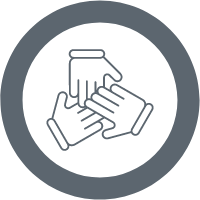Leverage Partner Expertise and Resources Organizational
Description
Employers do not need to develop and maintain expertise in all aspects of workforce development to effectively support their frontline workers. Drawing on the strengths of partners, like community-based organizations, education and training providers, and workforce investment boards, is an effective use of resources and demonstrates collaboration and a desire for collective impact. In these strategic partnerships, healthcare systems can concentrate on what they do best, and outside organizations can serve their community in support of their missions. Strong industry partnerships can facilitate relationship building among partners and leverage resources to address shared challenges and goals.
Process
When selecting partners, develop an assessment process to determine which organizations have the capacity, expertise, and ability to deliver quality service. Build relationships with potential partner organizations to determine if that organization is a good fit for your system. Clearly define roles, responsibilities, and expectations in a memorandum of understanding or contract. Explicitly articulate how programs and services will be funded.
External partnerships can be particularly helpful to provide the following services:
- Outreach to job candidates in specific communities or populations.
- Pre-screening assessments to ensure candidates meet minimum requirements.
- Connections to other services that promote work readiness, such as smoking cessation, basic literacy, or GED attainment programs.
- Pre-employment training, both for soft skills and for job-related competencies.
- Wrap-around supports, including transportation assistance, access to child care, mental health services, elder care, etc.
- Other services and support, like continuing education and training, onsite job coaching, financial literacy, and basic computer and technology training.
CareerSTAT Members Implementing This Practice
Trinity Health Michigan Region (Mercy Health and Saint Joesph Mercy Health)
Staten Island Performing Provider System
Rush University Medical Center
The Christ Hospital Health Network
Baylor Scott & White Health System
National Healthcareer Association
Resources
A Playbook for Fostering Hospital-Community Partnerships to Build a Culture of Health, Health Research & Educational Trust, 2017.
A playbook that provides strategies to create new partnerships and advance and sustain existing, effective partnerships.
Engaging Your Community: A Toolkit for Partnership, Collaboration, and Action, Office of Adolescent Health and John Snow, Inc, 2012.
A toolkit to assist organizations cultivate strategic partnerships, implement innovative outreach strategies, and develop robust communications that target the diverse organizations and populations in their communities.
ETA Sector Strategies Technical Assistance Initiative: Industry Champions, Employment and Training Administration, U.S. Department of Labor.
A brief to help workforce practitioners build a range of skills needed to launch and advance sector strategy approaches and connect readers to existing resources, best practices, and tools.
Collaboration Factors Inventory, 3rd Edition, Wilder Research, 2018.
A tool to assess how a collaboration is doing on research-tested success factors.
Partnership Assessment Tool for Health, Partnership for healthy Outcomes, 2017.
An assessment tool to help partnering organizations work together more effectively to maximize the impact of the partnership
Using Medicaid Levers to Support Health Care Partnerships with Community-Based Organizations, Partnership for Healthy Outcomes, 2017.
A fact sheet that shares key learnings about the benefits of these partnership between healthcare organizations and community-based organizations and offers strategies Medicaid can consider to better support these efforts.
Related Stories
Related Best Practices
Career Exploration Tools and Opportunities
PROGRAMMATIC | Job seekers and people in entry-level jobs may have had little opportunity to consider how to build a career.
Read MoreWork-Based Learning
PROGRAMMATIC | Work-based learning is an educational strategy combines classroom and real-life work experiences.
Read MoreBasic Skill Development
PROGRAMMATIC | Entry-level employees don’t always have the reading, math, technology, or English language skills to excel in their current position or advance their career.
Read MoreForm Industry Partnerships
ORGANIZATIONAL | The National Fund defines an industry partnership as a “dynamic collaboration of a regional group of employers that convene regularly with the assistance of a workforce intermediary.”
Read MoreCreate an Incumbent Worker Pipeline
PROGRAMMATIC | Employers sometimes overlook a prime talent pool to fill high demand positions — their current workforce.
Read MoreDedicated Workforce Staff or Units
ORGANIZATIONAL | Having a dedicated position or even entire units devoted to frontline workforce development is critical to prioritizing and scaling an effective workforce strategy.
Read More
